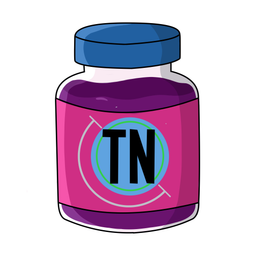Academia Slaying: Trans Youth Given HRT Will Almost Always Stay on HRT
The study brief, published Oct. 7, has powerful data but unfortunately the way it is written aligns with gender conservative animus.
- Home
- Academia Slaying
- Academia Slaying: Trans Youth Given HRT Will Almost Always Stay on HRT


The brief uses the Cass review in its literature review and argues for "comprehensive diagnostics" to limit transsexual medicine rather than push for our bodily autonomy.
By Artemis T. Douglas
On Oct. 7, an open access scientific brief was published in Acta Paediatrica - a top ranked international pediatric medicine journal - concerning trans youth and their attempts to transition.
The Austrian study provides data that disproves Gender-Conservative ideas of “desistance”, but its authors fall short of critiquing transphobic bunk science like the Cass Review- instead legitimizing and reinforcing it.
The brief describes a longitudinal study- meaning a study where they observed the same population multiple times over a long time- in this case the population was medically transitioning transsexual youth, and the period of time was an average of 4.2 years but up to 10.3 years.
The study found several things of interest, but the core assertion was that 97.1% of youth on transsexual medicine were still on HRT at the end of the study, with the average observed length of time on treatment being roughly 4 years.
In the authors’ words,
“Our findings show that treatment persistence was high from adolescence to young adulthood when GAHT was preceded by a structured, multi- stage diagnostic process and included interdisciplinary care.”
While the first half of that quoted summary is great, the second half reveals the authors’ apparent bias against transsexual bodily autonomy.
The data appears to be solid, but unfortunately the bias doesn’t start and end there.
In the brief’s introduction, the researchers foreground increased rates of children and youth expressing a desire to transition, the assumed need for a more robust diagnostic criteria to filter out transsexuals who aren’t going to stably transition, and the UK’s bunk science state propaganda also known as the Cass Review.
The study’s opening paragraph reads,
“There has been a global increase in young people seeking specialist treatment for gender incongruence [1]. For example, initial diagnoses of individuals aged 5–24 years increased eight- fold in Germany from 2013 to 2022. However, the low diagnostic persistence rate of less than 50% indicated the need for a standardised, multidisciplinary diagnostic process [2]. The 2024 Cass Review, commissioned by NHS England, recommended a cautious approach to medical interventions in adolescence. It also called for comprehensive diagnostics and robust long- term data on the outcomes of psychosocial and medical treatments.”
In other words, the researchers come out as unopposed to gatekeeping, managing, and limiting the number of transsexuals able to actually move from aspiring (wants to transition medically) to practicing (is actively or already has changed their sex through medical transition).
This bias may also be reflected in the trans youth that they sampled, due to the fact that 78 of 102 participants were trans masculine, that is, they wanted a transition along the lines of female to male. The other 24 were trans feminine.
In the context of the current moment, especially given that the researchers explicitly cited “global increases” in youth seeking transition and the Cass Review while also arguing for “comprehensive diagnostics”, this study unfortunately aligns with gender conservatives’ aims.
The actual data breakdown is interesting. The study’s sample had zero transfem participants end their transsexual medicine, whereas 3 transmasc participants did so.
However, the study notes that one of the three participants who stopped hormones didn’t detransition, but was rather stopping it in-progress, having achieved a level of masculinization they wanted (including chest surgery).
This means that less than 2% of their participants actually detransitioned, and the two who did were both transmasculine- 0% of transfeminine participants in this study detransitioned.
Another indicator of bias is how the study brief displays and codes the data.
The 78 transmasc participants all were coded as “Gender: Female” and the 24 transfem participants were similarly coded all as “Gender: Male.”
In other words, the way the data is displayed undermines the brief’s own findings.
The study’s power is in hard data showing that trans youth don’t detransition at the high rates gender conservatives have been promising.
This is despite those youth having to navigate within a transphobic, hostile society during the years when the study was conducted, 2012 to 2023.
However, the research itself is limited in its efficacy for transsexuals by the authors’ apparent biases.
The study concludes that,
“A careful diagnostic process may lead to more stable treatment outcomes and could explain our high persistence rate. Future research should combine extended follow-up periods with comprehensive assessments of treatment persistence, mental health, psychosocial functioning and the long- term consequences of medical interventions.”
Another way to understand this is that the study ends how it started- focusing more on the assumed consequences of transitioning in a cissexist society.
The authors’ framing aligns with ideas of medical professionals seeking to avoid those consequences by limiting transition to reduce the number of transsexuals who actually change their sex.
The study could have instead committed to using its data to challenge the gatekeeping notion and patriarchal logic that undergirds the entire anti-trans animus.
Unfortunately, that is not how the authors wrote their report.
Editor's Note: After our audience provided a tip with additional context, we published an update to this story, available below.
 The Needle - NewsArtemis T. Douglas
The Needle - NewsArtemis T. Douglas
If you’d like to read the original article, it’s open access at this link. If you prefer a formal citation style, there’s one below.
Feil, K., Senoner, L., Fuchs, M., Leonhardt, A., Reiser, E., Sevecke, K., & Toth, B. (2025). Treatment persistence was high when hormone therapy for gender incongruence included comprehensive diagnoses and interdisciplinary care during adolescence. Acta Paediatrica. https://doi.org/10.1111/apa.70337
Sign up for The Needle
Culture and News: By and For Transsexuals
No spam. Unsubscribe anytime.
